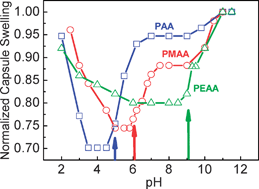We report on tuning swelling pH transitions of hydrogel hollow capsules that were derived from hydrogen-bonded multilayers via chemical cross-linking. The capsules were either of a single component – a weak poly(carboxylic acid), such as poly(acrylic acid) (PAA), poly(methacrylic acid) (PMAA), or poly(ethacrylic acid) (PEAA) – or contained two hydrogen-bonding polymers, such as in poly(carboxylic acid)/poly(N-vinylpyrrolidone-co-NH2) (PVPON-co-NH2) or in poly(carboxylic acid)/poly(N-vinylcaprolactam-co-NH2) (PVCL-co-NH2) systems. By varying the acidity of weak polyelectrolytes, the capsule swelling can be tuned over a wide pH range from 5 to 10. We show that differently from one-component capsules, the swelling amplitude of two-component capsules is limited by the number of cross-links provided by amino-containing units of a PVCL-co-NH2copolymer. For two-component capsules with the same degree of cross-linking, permeability at the minimum swelling pH was decreased for PMAA–neutral copolymer capsules as compared to those of PAA–neutral copolymer. We also demonstrate that swelling pH of one-component capsules in the acidic region can be modulated via reversible association with a polycation. The fine control over the swelling pH transitions and permeability of hydrogel capsules enables their use in biomedical applications.

You have access to this article
 Please wait while we load your content...
Something went wrong. Try again?
Please wait while we load your content...
Something went wrong. Try again?


 Please wait while we load your content...
Please wait while we load your content...